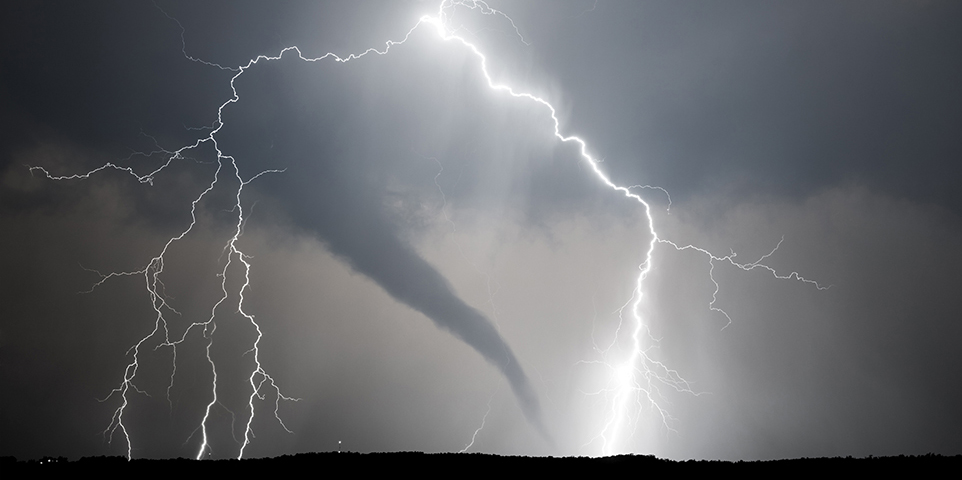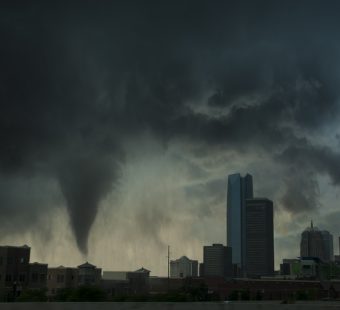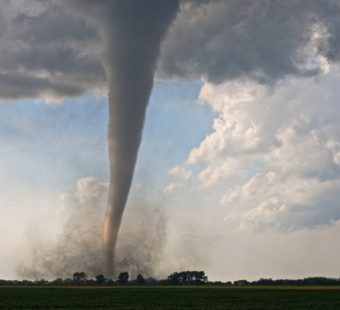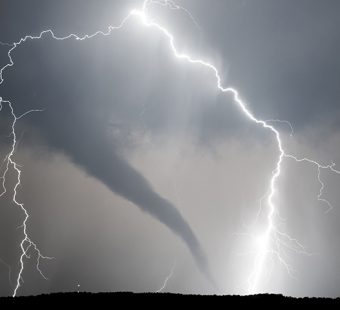
Tornado facts and safety
When atmospheric conditions are right, tornadoes can strike with little warning and cause grave amounts of damage in a very short time. These tips can help minimize your risk and keep you and your family safe.
What is a tornado?
A tornado—also known as a twister—is a violently rotating column of air that extends from a thunderstorm and comes into contact with the ground. Tornado intensity is measured by the Enhanced Fujita (EF) scale, which rates tornadoes from 0 through 5, based on the amount and type of wind damage.
How common are tornadoes?
An average of about 1,000 tornadoes are reported nationwide each year. Twisters are more common in the central United States, though they can occur almost anywhere in North America, including in large cities.
Tornadoes can happen at any time of year or at any time of the day or night, though they happen most frequently between early spring and July, and between the hours of 4pm and 9pm.
What are the warning signs of a tornado?
Signs that a twister is coming include:
- Dark greenish skies
- Large hail
- Dark, rotating, low-altitude cloud
- Loud roar, like a train
Despite the fact that meteorologists are now better able to predict them, tornadoes can strike with little warning. Therefore, it’s best to be prepared well before a tornado approaches. For tips, handy checklists (including ones you can personalize yourself) and planning advice to cover a variety of situations, get the I.I.I.’s Know Your Plan app. It’s a great tool to help get you and your family—including pets—organized and ready to act more quickly if disaster strikes.
In communities with a history of tornado activity, there may be a tornado warning siren and/or a digital messaging system to alert residents that there is a twister coming and that they should seek proper shelter immediately.
What’s the difference between a tornado watch and a tornado warning?
Both tornado watches and tornado warnings are issued by the National Oceanic and Atmospheric Administration (NOAA)/ National Weather Service. However, there are critical differences between the two alerts.
- A tornado watch means that conditions are favorable for tornadoes to develop. Be alert to changes in the weather, account for all family members, and listen to local radio and TV stations for updated storm information. Move cars inside and keep car and house keys with you. If time permits, move lawn furniture and equipment inside to minimize flying debris. If a tornado siren sounds, stay inside and take cover.
- A tornado warning means a tornado has actually been spotted or is indicated on weather radar in your area. This means danger is imminent and you may only have seconds to take cover.
What to do when a tornado has been sighted
When a tornado warning sounds or a tornado has been sighted, do not try to outrun it. Stay calm but quickly seek shelter in the safest place possible.
- If you are at home, the safest place to be is underground. Basements are usually the most protected area, but if this is not an option take cover in central part of the house away from windows—for example in a bathroom, closet, interior hallway or under a heavy piece of furniture.
- If you are in an office building or skyscraper, go directly to an enclosed, windowless area in the center of the building—away from glass and on the lowest floor possible—and crouch down and cover your head. Interior stairwells are usually good places to take shelter and, if they are not crowded, allow you to get to a lower level quickly. Stay off elevators, you could get trapped if the power is lost. If you are in a tall building you may not have enough time to evacuate to the lowest floor.
- If you are at school follow the staff instructions and go to an interior hall or room in an orderly way as directed. Crouch low, head down, and protect the back of your head with your arms. Stay away from windows and large open rooms like gyms and auditoriums.
- If you are in a car or truck, abandon the vehicle and seek shelter in sturdy structure. If you are in open country, seek shelter in the nearest ditch. Lie flat, facedown on low ground, protecting the back of your head with your arms. Get as far away from trees and cars as you can.
- If you are in a mobile home, get out! Even if the home is tied down, you are probably safer outside.
Safety precautions to take after a tornado
Tornadoes can cause dangerous damages, so take caution with potential hazards after the storm.
- Stay in your shelter until after the storm is over or until emergency personnel have arrived.
- Check the people around you for injuries. If necessary, begin first aid or seek help.
- Check your utility lines and appliances for damage. If you smell gas, open the windows and turn off the main valve. Don’t turn on lights or appliances until the gas has dissipated. If electric wires are shorting out, turn off the power.
- Outside, watch out for downed power lines and stay away from any puddle with wires in them. These could be carrying deadly live current.
- Be aware there may be leaking gas pipes or fuel tanks nearby. The oil from these can be present in water or on the ground, so avoid using matches or lighters.
Recovering from a tornado
Damage caused by tornadoes is covered under standard homeowners and business insurance policies, and under the optional comprehensive portion of an auto insurance policy.
If you sustain tornado damage:
- Contact your insurer as soon as possible and start the claims filing process. After tornadoes and other disasters, insurance companies will reach out to those with the worst losses first.
- Take photos of any damage. A photographic record is useful when making insurance claims.
- Make temporary repairs to prevent further loss from rain, wind or looting; these costs are reimbursable under most policies, so save the receipts.
- Make a detailed list of all damaged or destroyed personal property. If you have a home inventory, it will be extremely useful here. Don’t throw out damaged property until you have met with an adjuster.
- Don’t rush to sign repair contracts. Do your homework, deal with reputable contractors and get references. Be sure of payment terms and consult your insurance adjuster before you sign any contracts.
- If your home is uninhabitable because of tornado damage, your homeowners or renters insurance provides coverage for additional living expenses (ALE) such as hotel bills or meals out. Save all related receipts and, if you have vacated your home premises, make sure your insurance representative knows where and how to contact you.
- Talk to your insurance professional if you have any questions about any part of your insurance coverage.
Additional Resources
National Weather Service alerts
NOAA/National Weather Service Storm Prediction Center
Next steps link: Another atmospheric hazard that can strike quickly is lightning—stay safe by learning the difference between lightning myth and fact.



